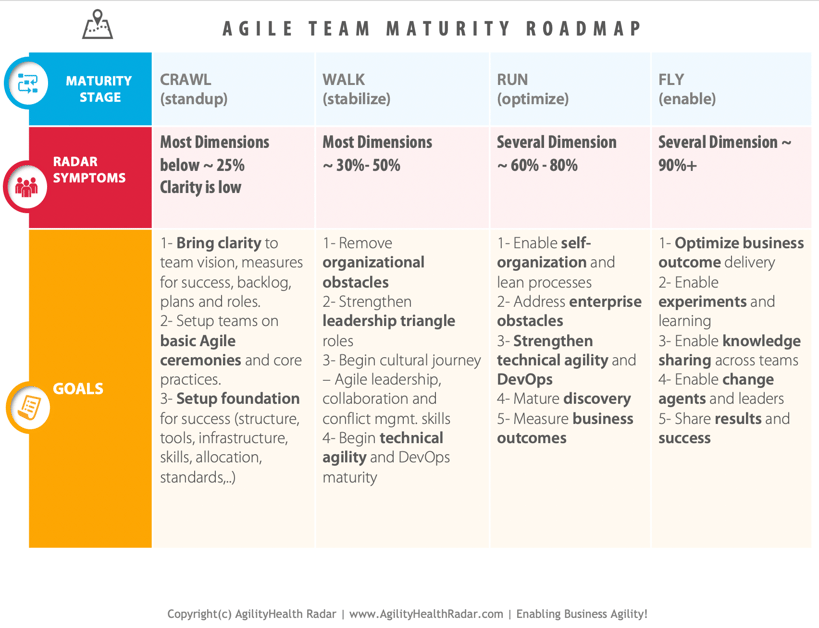How do you improve team maturity?
At AgilityHealth®, we believe healthy, high-performing teams are the most mature. Healthy teams are those that are sized appropriately with skilled team members who understand their roles and what is expected of them. These teams are able to self-organize around the work and members are T-shaped, which enables each to contribute to the work.
High-performing teams take these items even further and work together to find creative and innovative solutions while breaking the work down into smaller increments of value they then deliver on schedule. Improving team maturity takes time and it begins with measurement.
Measurement is Key
It’s important to measure teams with consistent and repeatable methods, as well as to develop guidance for growth that can be scaled across many teams easily. Ensuring team members are assessed in multiple competency areas will help provide an all-encompassing view of their happiness, team culture, leadership effectiveness, alignment to the company vision, team performance metrics, and more.
When teams are answering assessment questions related to their health, performance, and maturity, each team member will have an idea of what “good” looks like, but without a shared understanding of “good”, one team member’s “good” might be an 8 on the rating scale, their teammate’s might be a 7, someone else’s might be a 10, and so on. Sharing common definitions to provide context for your assessment questions will help ensure your results are less subjective and teams are being measured the same way.
Once the above items have been established, allow team members to measure themselves in a safe environment where they can be open and honest about their maturity with a neutral facilitator, ensuring their psychological safety and the probability of receiving results that reflect reality.

Looking at maturity from only the team perspective provides a limited view but combining their perspective with the confidence level from leadership and stakeholders constructs a three-dimensional view. Rolling measurement results up into product lines, portfolios, or across the entire organization gives a clearer picture of how an organization is performing overall. This also allows common patterns among teams to emerge, leading to easier decisions about where to focus shared resources for growth.
Roadmap for Growth
Along with a consistent scale to measure team health and maturity, there also needs to be a proven roadmap for teams to follow as guidance for their growth. New teams need different assistance than mature teams but all teams should have consistent guidance available across an organization.
Provide a maturity roadmap for teams to follow that describes the stages of team maturity including what each stage ‘feels’ like to a team, common experiences of teams in that stage, and resources for them to utilize to grow into the next stage. Showing teams what healthy or unhealthy looks like at every stage, sharing videos, providing training for specific roles, and bringing in Agile Coaches for guidance is a good starting point.

Another option is to encourage teams in more mature stages to partner with teams in need of assistance through a peer-to-peer training program. You could offer a mentoring program for specific roles to learn from more experienced people in those same roles or develop Communities of Practice for common roles in your organization.
Let teams review their assessment results and pick a few items to focus on improving before the next assessment. Teams can create these ‘growth items’ and work them into their sprints to ensure the work is being done. Allowing teams to bubble up the ‘growth items’ they need help resolving to leadership allows teams to be empowered to speak up and leaders to assist where it is needed most.
Build an Atmosphere of Continuous Improvement
The key to helping teams mature is to ensure they feel safe and supported in doing so. Measurements and feedback from team members must only be used to reward or inspire growth opportunities, never to punish. Engage leadership early in the process and help them to find common patterns among the teams. Encourage leadership to remove impediments brought forth by teams and to invest in resources that will enable growth. Be sure to celebrate the progress made by both the teams in their maturity growth and the impediments leadership resolves. Building an atmosphere of continuous improvement throughout your organization will benefit everyone and create a positive environment for growth.
Help Your Teams Today
AgilityHealth® Radar Assessments help you quickly measure the current health, performance, and maturity of your teams, build actionable plans, and enable self-learning and growth at all levels of your organization. The TeamHealth Radar assessment is a great place to start!



Comments